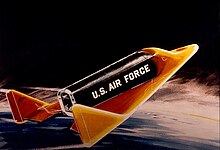Dyna-Soar
The Boeing X-20 Dyna-Soar ("Dynamic Soarer") was a United States Air Force (USAF) program to develop a spaceplane that could be used for a variety of military missions, including aerial reconnaissance, bombing, space rescue, satellite maintenance, and as a space interceptor to sabotage enemy satellites. The program ran from October 24, 1957 to December 10, 1963, cost US$660 million ($5.16 billion today), and was cancelled just after spacecraft construction had begun.
Other spacecraft under development at the time, such as Mercury or Vostok, were based on space capsules that returned on ballistic re-entry profiles. Dyna-Soar was more like the much later Space Shuttle. It could not only travel to distant targets at the speed of an intercontinental ballistic missile, it was designed to glide to earth like an aircraft under control of a pilot. It could land at an airfield, rather than simply falling to earth and landing with a parachute. Dyna-Soar could also reach earth orbit, like Mercury or Gemini.
These characteristics made Dyna-Soar a far more advanced concept than other human spaceflight missions of the period. Research into a spaceplane was realized much later, in other reusable spacecraft such as the Space Shuttle, which had its first orbital flight in 1981, and, more recently, the Boeing X-40 and X-37B spacecraft.
Following World War II, many German scientists were taken to the United States by the Office of Strategic Services's "Operation Paperclip". Among them was Dr. Walter Dornberger, the former head of Germany's wartime rocket program, who had detailed knowledge of Eugen Sänger's Silbervogel project. Working for Bell, he attempted to create interest in a boost-glide system in the USAF, and elsewhere. This resulted in the USAF requesting a number of feasibility and design studies – carried out by Bell, Boeing, Convair, Douglas, Martin, North American, Republic, and Lockheed – for boost-glide vehicles during the early 1950s:
...
Wikipedia

